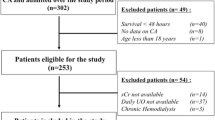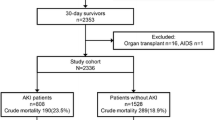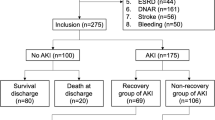Abstract
Purpose
Characteristics of acute kidney injury (AKI) occurring after out-of-hospital cardiac arrest (OHCA) are incompletely described. We aimed to evaluate the prevalence of AKI, identifying risk factors and assessing the impact of AKI on outcome after OHCA.
Methods
Single-center study between 2007 and 2012 in a cardiac arrest center in Paris, France. All consecutive OHCA patients with at least one weight measurement and one serum creatinine level available and treated by therapeutic hypothermia were included, except those with chronic kidney disease and those dead on arrival. AKI was defined as stage 3 of the Acute Kidney Injury Network (AKIN) classification. Main outcome was day-30 mortality. Factors associated with AKI occurrence and day-30 mortality were evaluated by logistic regression.
Results
580 patients (71.3 % male, median age 59.3 years, initial shockable rhythm in 56.9 % of cases) were included in the analysis. AKI stage 3 occurred in 280 (48.3 %) patients. Age, male gender, resuscitation duration, post-resuscitation shock, public setting, and initial rhythm were associated with AKI stage 3. AKI stage 3 was associated with a significantly higher day-30 mortality rate [OR 1.60; 95 % CI (1.05, 2.43); p = 0.03]. No independent association between AKI and neurologic outcome was observed. At day 30, 67 patients had a normal kidney function (eGFR >75 mL/min/1.73 m2), and five remained dialysis-dependent. Patients with eGFR higher than 75 mL/min/1.73 m2 at day 30 were younger and more frequently male.
Conclusion
AKI stage 3 was frequent after OHCA and was associated with poorer outcome. Improvement strategies in post-resuscitation care should consider AKI as a potential target of treatment.


Similar content being viewed by others
References
Atwood C, Eisenberg MS, Herlitz J, Rea TD (2005) Incidence of EMS-treated out-of-hospital cardiac arrest in Europe. Resuscitation 67:75–80. doi:10.1016/j.resuscitation.2005.03.021
Sasson C, Rogers MAM, Dahl J, Kellermann AL (2010) Predictors of survival from out-of-hospital cardiac arrest: a systematic review and meta-analysis. Circ Cardiovasc Qual Outcomes 3:63–81. doi:10.1161/CIRCOUTCOMES.109.889576
Neumar RW, Nolan JP, Adrie C et al (2008) Post-cardiac arrest syndrome: epidemiology, pathophysiology, treatment, and prognostication. A consensus statement from the International Liaison Committee on Resuscitation (American Heart Association, Australian and New Zealand Council on Resuscitation, European Resuscitation Council, Heart and Stroke Foundation of Canada, Inter American Heart Foundation, Resuscitation Council of Asia, and the Resuscitation Council of Southern Africa); the American Heart Association Emergency Cardiovascular Care Committee; the Council on Cardiovascular Surgery and Anesthesia; the Council on Cardiopulmonary, Perioperative, and Critical Care; the Council on Clinical Cardiology; and the Stroke Council. Circulation 118:2452–2483. doi:10.1161/CIRCULATIONAHA.108.190652
Lemiale V, Dumas F, Mongardon N et al (2013) Intensive care unit mortality after cardiac arrest: the relative contribution of shock and brain injury in a large cohort. Intensive Care Med 39:1972–1980. doi:10.1007/s00134-013-3043-4
Mongardon N, Dumas F, Ricome S et al (2011) Postcardiac arrest syndrome: from immediate resuscitation to long-term outcome. Ann Intensive Care 1:45. doi:10.1186/2110-5820-1-45
Mattana J, Singhal PC (1993) Prevalence and determinants of acute renal failure following cardiopulmonary resuscitation. Arch Intern Med 153:235–239
Domanovits H, Schillinger M, Müllner M et al (2001) Acute renal failure after successful cardiopulmonary resuscitation. Intensive Care Med 27:1194–1199
Domanovits H, Müllner M, Sterz F et al (2000) Impairment of renal function in patients resuscitated from cardiac arrest: frequency, determinants and impact on outcome. Wien Klin Wochenschr 112:157–161
Chua H-R, Glassford N, Bellomo R (2012) Acute kidney injury after cardiac arrest. Resuscitation 83:721–727. doi:10.1016/j.resuscitation.2011.11.030
O’Connor RE, Bossaert L, Arntz H-R et al (2010) Part 9: acute coronary syndromes: 2010 international consensus on cardiopulmonary resuscitation and emergency cardiovascular care science with treatment recommendations. Circulation 122:S422–S465. doi:10.1161/CIRCULATIONAHA.110.985549
Susantitaphong P, Alfayez M, Cohen-Bucay A et al (2012) Therapeutic hypothermia and prevention of acute kidney injury: a meta-analysis of randomized controlled trials. Resuscitation 83:159–167. doi:10.1016/j.resuscitation.2011.09.023
Zeiner A, Sunder-Plassmann G, Sterz F et al (2004) The effect of mild therapeutic hypothermia on renal function after cardiopulmonary resuscitation in men. Resuscitation 60:253–261. doi:10.1016/j.resuscitation.2003.11.006
Barrantes F, Tian J, Vazquez R et al (2008) Acute kidney injury criteria predict outcomes of critically ill patients. Crit Care Med 36:1397–1403. doi:10.1097/CCM.0b013e318168fbe0
Mandelbaum T, Scott DJ, Lee J et al (2011) Outcome of critically ill patients with acute kidney injury using the acute kidney injury network criteria. Crit Care Med 39:2659–2664. doi:10.1097/CCM.0b013e3182281f1b
Vaara ST, Pettilä V, Kaukonen K-M et al (2014) The attributable mortality of acute kidney injury: a sequentially matched analysis. Crit Care Med 42:878–885. doi:10.1097/CCM.0000000000000045
Uchino S, Kellum JA, Bellomo R et al (2005) Acute renal failure in critically ill patients: a multinational, multicenter study. JAMA 294:813–818. doi:10.1001/jama.294.7.813
Abe D, Sato A, Hoshi T et al (2013) Clinical predictors of contrast-induced acute kidney injury in patients undergoing emergency versus elective percutaneous coronary intervention. Circ J 78:85–91
Tsai TT, Patel UD, Chang TI et al (2014) Contemporary incidence, predictors, and outcomes of acute kidney injury in patients undergoing percutaneous coronary interventions: insights from the NCDR Cath-PCI registry. JACC Cardiovasc Interv 7:1–9. doi:10.1016/j.jcin.2013.06.016
Rihal CS, Textor SC, Grill DE et al (2002) Incidence and prognostic importance of acute renal failure after percutaneous coronary intervention. Circulation 105:2259–2264
Yanta J, Guyette FX, Doshi AA et al (2013) Renal dysfunction is common following resuscitation from out-of-hospital cardiac arrest. Resuscitation. doi:10.1016/j.resuscitation.2013.03.037
Guillemet L et al (2014) Acute kidney injury after out-of-hospital cardiac arrest: prevalence, risk factors and outcome. Presented at the European Society of Intensive Care Medicine (ESICM) congress, Barcelona, 27 September–1 October 2014
Cummins RO, Chamberlain D, Hazinski MF et al (1997) Recommended guidelines for reviewing, reporting, and conducting research on in-hospital resuscitation: the in-hospital “Utstein style”. American Heart Association. Circulation 95:2213–2239
Dumas F, Cariou A, Manzo-Silberman S et al (2010) Immediate percutaneous coronary intervention is associated with better survival after out-of-hospital cardiac arrest: insights from the PROCAT (Parisian region out of hospital cardiac arrest) registry. Circ Cardiovasc Interv 3:200–207. doi:10.1161/CIRCINTERVENTIONS.109.913665
Chelly J, Mongardon N, Dumas F et al (2012) Benefit of an early and systematic imaging procedure after cardiac arrest: insights from the PROCAT (Parisian region out of hospital cardiac arrest) registry. Resuscitation 83:1444–1450. doi:10.1016/j.resuscitation.2012.08.321
Spaulding CM, Joly LM, Rosenberg A et al (1997) Immediate coronary angiography in survivors of out-of-hospital cardiac arrest. N Engl J Med 336:1629–1633. doi:10.1056/NEJM199706053362302
Mehta RL, Kellum JA, Shah SV et al (2007) Acute kidney injury network: report of an initiative to improve outcomes in acute kidney injury. Crit Care 11:R31. doi:10.1186/cc5713
Levey AS, Bosch JP, Lewis JB et al (1999) A more accurate method to estimate glomerular filtration rate from serum creatinine: a new prediction equation. Modification of Diet in Renal Disease Study Group. Ann Intern Med 130:461–470
Nisula S, Kaukonen K-M, Vaara ST et al (2013) Incidence, risk factors and 90-day mortality of patients with acute kidney injury in Finnish intensive care units: the FINNAKI study. Intensive Care Med 39:420–428. doi:10.1007/s00134-012-2796-5
Joannidis M, Metnitz B, Bauer P et al (2009) Acute kidney injury in critically ill patients classified by AKIN versus RIFLE using the SAPS 3 database. Intensive Care Med 35:1692–1702. doi:10.1007/s00134-009-1530-4
Hasper D, von Haehling S, Storm C et al (2009) Changes in serum creatinine in the first 24 hours after cardiac arrest indicate prognosis: an observational cohort study. Crit Care 13:R168. doi:10.1186/cc8144
Vanston VJ, Lawhon-Triano M, Getts R et al (2010) Predictors of poor neurologic outcome in patients undergoing therapeutic hypothermia after cardiac arrest. South Med J 103:301–306. doi:10.1097/SMJ.0b013e3181d3cec2
Adrie C, Adib-Conquy M, Laurent I et al (2002) Successful cardiopulmonary resuscitation after cardiac arrest as a “sepsis-like” syndrome. Circulation 106:562–568
Dumas F, White L, Stubbs BA et al (2012) Long-term prognosis following resuscitation from out of hospital cardiac arrest: role of percutaneous coronary intervention and therapeutic hypothermia. J Am Coll Cardiol 60:21–27. doi:10.1016/j.jacc.2012.03.036
Tumlin J, Stacul F, Adam A et al (2006) Pathophysiology of contrast-induced nephropathy. Am J Cardiol 98:14K–20K. doi:10.1016/j.amjcard.2006.01.020
Hoste EAJ, Doom S, De Waele J et al (2011) Epidemiology of contrast-associated acute kidney injury in ICU patients: a retrospective cohort analysis. Intensive Care Med 37:1921–1931. doi:10.1007/s00134-011-2389-8
Schetz M, Gunst J, Van den Berghe G (2014) The impact of using estimated GFR versus creatinine clearance on the evaluation of recovery from acute kidney injury in the ICU. Intensive Care Med 40:1709–1717. doi:10.1007/s00134-014-3487-1
Pickering JW, Ralib AM, Endre ZH (2013) Combining creatinine and volume kinetics identifies missed cases of acute kidney injury following cardiac arrest. Crit Care 17:R7. doi:10.1186/cc11931
Acknowledgments
GG, LG, VL, CV, and AC designed the study. GG, LG, JC, MA, VL, and WB collected the data. GG performed the statistical analysis. GG and LG wrote the manuscript. FD, VL, LL, JPM, and AC reviewed the manuscript. GG and AC take responsibility for the integrity of the work. We thank Nancy Kentish-Barnes for her help in preparing the manuscript.
Conflicts of interest
None.
Author information
Authors and Affiliations
Corresponding author
Additional information
G. Geri and L. Guillemet equally contributed to this work.
Electronic supplementary material
Below is the link to the electronic supplementary material.
Rights and permissions
About this article
Cite this article
Geri, G., Guillemet, L., Dumas, F. et al. Acute kidney injury after out-of-hospital cardiac arrest: risk factors and prognosis in a large cohort. Intensive Care Med 41, 1273–1280 (2015). https://doi.org/10.1007/s00134-015-3848-4
Received:
Accepted:
Published:
Issue Date:
DOI: https://doi.org/10.1007/s00134-015-3848-4




